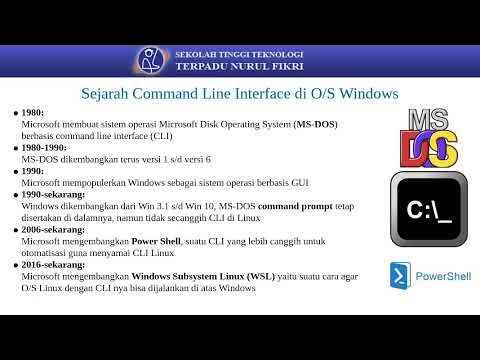Introduction to Linux and Basic Linux Commands for Beginners
Summary
TLDRThis video provides a beginner-friendly introduction to Linux, focusing on using basic commands through the terminal. It covers the differences between Linux and UNIX, the use of VirtualBox to run Linux on a Windows system, and the importance of the command-line interface (CLI). The tutorial demonstrates commands like PWD, LS, CD, CP, and RM, and explains how to navigate directories, copy files, and delete folders. It also highlights the use of the MAN command for finding information on other commands. The video aims to help viewers become comfortable with Linux terminal basics.
Takeaways
- 💻 Linux is a powerful operating system, distinct from UNIX, created by Linus Torvalds in 1991.
- ⚙️ Linux is widely used on servers and supercomputers, running on 90% of the world's fastest systems due to its reliability.
- 📂 There are many Linux distributions (distros), such as Ubuntu, Fedora, Mint, and Debian, with Ubuntu being featured in this tutorial.
- 📋 The GUI (Graphical User Interface) in Linux is not the focus of this tutorial; instead, the focus is on using the CLI (Command Line Interface) through a terminal.
- 🏠 The PWD command (Print Working Directory) shows the current directory you're in, while the LS command lists the files and folders in that directory.
- 📁 The CD command is used for navigation within the filesystem, allowing you to move between directories and navigate to specific folders.
- 📄 The CP command copies files from one directory to another, and the RM command removes files from the current directory.
- 🗂️ MKDIR creates a new directory, while RMDIR removes an empty directory. To delete a directory containing files, you need to use the RM command with the -R option.
- 📖 The MAN command provides manual pages for Linux commands, offering detailed explanations and options for commands like LS and CP.
- 👍 The tutorial covers basic Linux commands and encourages viewers to subscribe for more Linux tutorials, offering additional resources and social media connections.
Q & A
What is the difference between Linux and UNIX?
-Linux and UNIX are different operating systems. UNIX was created by AT&T employees in 1969, while Linux was written by Linus Torvalds and released in 1991.
What are Linux distributions, and can you name a few examples?
-Linux distributions, or distros, are different versions of Linux that come with various features and package management systems. Examples include Ubuntu, Fedora, Mint, and Debian. Even Android is a Linux distribution.
What is the purpose of using VirtualBox in this tutorial?
-VirtualBox is used to install and run a Linux operating system within another system, like Windows. In the tutorial, Ubuntu Linux is installed inside VirtualBox running on a Windows 7 machine.
What is the difference between GUI and CLI in Linux?
-GUI (Graphical User Interface) provides a visual way to interact with the operating system, like icons and windows, while CLI (Command Line Interface) relies on text-based commands to navigate and operate the system.
What does the 'PWD' command do in Linux?
-The 'PWD' command stands for 'Print Working Directory'. It shows the user their current location in the file system.
How do you navigate between directories using the 'CD' command?
-The 'CD' command is used to navigate between directories. You can enter a directory with 'cd <directory_name>' or go back to the previous directory using 'cd ..'.
What does the 'LS' command do in Linux?
-The 'LS' command lists all the files and directories in the current directory.
How do you copy and move files using the 'CP' command?
-The 'CP' command is used to copy files. You can specify the file to be copied and the destination folder. For example, 'cp test /home/user/Downloads' copies the 'test' file to the Downloads folder.
How can you delete a file or directory in Linux?
-You can delete a file using the 'RM' command. For directories, use 'rmdir <directory_name>' if the directory is empty, or 'rm -r <directory_name>' if it contains files.
What is the 'man' command used for in Linux?
-The 'man' command provides a manual for other Linux commands, offering detailed explanations and options. For example, 'man ls' shows the manual for the 'LS' command.
Outlines

Этот раздел доступен только подписчикам платных тарифов. Пожалуйста, перейдите на платный тариф для доступа.
Перейти на платный тарифMindmap

Этот раздел доступен только подписчикам платных тарифов. Пожалуйста, перейдите на платный тариф для доступа.
Перейти на платный тарифKeywords

Этот раздел доступен только подписчикам платных тарифов. Пожалуйста, перейдите на платный тариф для доступа.
Перейти на платный тарифHighlights

Этот раздел доступен только подписчикам платных тарифов. Пожалуйста, перейдите на платный тариф для доступа.
Перейти на платный тарифTranscripts

Этот раздел доступен только подписчикам платных тарифов. Пожалуйста, перейдите на платный тариф для доступа.
Перейти на платный тарифПосмотреть больше похожих видео

How to use the Command Line | Terminal Basics for Beginners

Basic Commands | Operations in Kali | Understanding Environment [Hindi] | Kali Linux #2

Understanding Variables on the Linux Command-Line

Sistem Operasi 14

Kali Linux Basics for Beginners || Tutorial (2023/2024)

Linux Mint Terminal Commands for Beginners
5.0 / 5 (0 votes)
